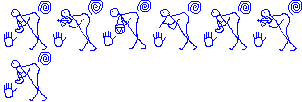Simon Ortiz
-
My oldest sister wears thick glasses
because she can't see very well.
She makes beautifully formed pottery.
That's the thing about making dhyuuni;
it has more to do with a sense of touching
than with seeing because fingers
have to know the texture of clay
and how the pottery is formed from lines
of shale strata and earth movements.
The pottery she makes is thinwalled
and has a fragile but definite balance.
In other words, her pottery has a true ring
when it is tapped with a finger knuckle.Here, you try it;
you'll know what I mean.The design that my mother is painting
onto the bowl is done with a yucca stem brush.
My other sister says, "Our mother,
she can always tell when someone else has used
a brush that she is working with," because
she has chewed it and made it into her own way.
She paints with movements whose origin
has only to do with years of knowing
just the right consistency of paint,
the tensile vibrancy of the yucca stem,
and the design that things are supposed to have.She can always tell.
My mother talks about one time.
"One time, my sister and I
and this one lady - she was
a fat woman - went to roast piñons.
Stuwahmeeskuunaati, over that way."
To the east of Aacqu the mesa cliffs
are red, brown, and white sandstone;
there are piñon trees there.
"We left in the morning
and walked up to the first level,
not on top, where there was a lot
of piñons that year.
We had to get the piñons
in their cones from the trees
and dig a hole and bury them
and then build a fire on top.
It took quite a while
to do that, like it does.
And then we got them out
and let them cool,
and then we gathered them
up and put them on our backs
in sacks. We started back
to Aacqu." It's a long ways
across the valley, sandhills,
grasses, brush, cottonwoods,
gullies, cacti. "When we got
to this one place, the woman said,
`This is where Maashadruwee lives.
You have to holler.'
You're supposed to yell or holler.
We prayed with cornmeal
and the lady said, `Please
Maashadruwee, make Aacqu closer
to us.' And we started again
but before we got to Aacqu
onto the south trail,
it grew dark.
We knew that our relatives
would worry about us.
And sure enough, the woman's husband
was looking and he met us
at the bottom of the trail.
When we got to south of the church,
my father met us - he had come
to look for us too."
My mother chuckles at the memory
of it, when she was a young girl.
"I don't know if my sister
remembers, but I do, very clearly.
But I don't know
what my age was then."
From Woven Stone by Simon Ortiz, Vol. 21, in Sun Tracks an American Indian Literary Series, University of Arizona Press
© 1992 Simon Ortiz

Books by Simon Ortiz
- Woven Stone, Simon Ortiz, Univ. Arizona Press. (Hardcover)
- Men on the Moon : Collected Short Stories, Simon Ortiz, Univ. Arizona Press. (Hardcover)
- After and Before the Lightning , Simon Ortiz, Univ. Arizona Press. (Hardcover)
- Speaking for the Generations : Native Writers on Writing, Simon Ortiz (Editor), Univ. Arizona Press.
- From Sand Creek : Rising in This Heart Which Is Our America, Simon Ortiz, Univ. Arizona Press.
- The People Shall Continue, Simon Ortiz, Children's Book Press. (Library Binding)
- Men on the Moon : Collected Short Stories, Simon Ortiz, Univ. Arizona Press. (Hardcover)
Return to Day 7
